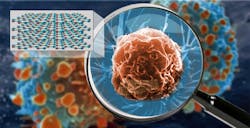Hyperlens crystal is capable of viewing living cells at nanometer scale
An optical lens that can resolve features the size of a small virus on the surface of a living cell in its natural environment has been developed by a team of researchers led by Joshua Caldwell, associate professor of mechanical engineering at Vanderbilt University (Nashville, TN).1 The lens was made possible due to a fundamental advance in the quality of an optical material used in hyperlensing, a method of creating lenses that can resolve objects much smaller than the wavelength of light.
The optical material involved is hexagonal boron nitride (hBN), a natural crystal with hyperlensing properties. The best previously reported resolution using hBN was an object about 36 times smaller than the infrared wavelength used: about the size of the smallest bacteria. The new paper describes improvements in the quality of the crystal that enhance its potential imaging capability by about a factor of ten.
RELATED: New twists on superlenses improve subwavelength microscopy
The researchers achieved this enhancement by making hBN crystals using isotopically purified boron. Natural boron contains two isotopes that differ in weight by about 10%, a combination that significantly degrades the crystal's optical properties in the infrared.
Researchers from the University of California, San Diego, Kansas State University, Oak Ridge National Laboratory and Columbia University also contributed to the study.
The researchers calculate that a lens made from their purified crystal can in principle capture images of objects as small as 30 nm in size. The conventional diffraction limit of about a half a wavelength is surpassed by using hBN due to its ability to support surface phonon polaritons, hybrid particles made up of photons of light coupling with vibrating, charged atoms in a crystal that have wavelengths much shorter than the incident light.
In the past, the problem with using polaritons in this fashion has been the rapidity with which they dissipate. By using hBN crystals made from 99% isotopically pure boron, the researchers measured a dramatic reduction in optical losses compared to natural crystals, increasing the polariton's lifetime three-fold, which allows them to travel triple the distance. This improvement translates into a significant improvement in imaging resolution. The researchers' theoretical analysis suggests that another factor of ten improvement is possible.
REFERENCE:
1. Alexander J. Giles et al., Nature Materials (2017); doi: 10.1038/nmat5047
About the Author
John Wallace
Senior Technical Editor (1998-2022)
John Wallace was with Laser Focus World for nearly 25 years, retiring in late June 2022. He obtained a bachelor's degree in mechanical engineering and physics at Rutgers University and a master's in optical engineering at the University of Rochester. Before becoming an editor, John worked as an engineer at RCA, Exxon, Eastman Kodak, and GCA Corporation.

